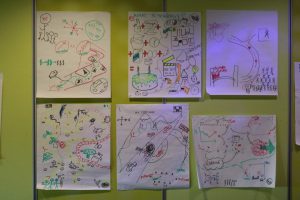Rich Pictures

Creating a new product or service, introducing a new production methodology, changing culture, creating new ways of working, addressing debilitting problems and challenges, and dealing with complexity, within organisations – requires a holistic, broad perspective. It is very easy to take a local view of what is going on in problem situations during ongoing cycles of organisational change, and to seek to positively influence what is going on. The situation is usually more than just one issue.
There is usually an interrelationship between multiple ideas, events, perspectives, systems, and so on. A very simple yet rich way of understanding the bigger picture is to draw one. ‘Rich pictures’ are useful when lots of different people are involved, all of whom have different ideas of what the problem is and how to improve the situation. They encourage a systemic and cultural view of the problem situation that takes account of interaction effects between different elements of the system – including people! Healthy connections lead to healthy systems. In human systems, the connection points are mostly the conversations that people have with each other.
Here is a short video of how to use the Rich Picture Technique.
VIEW ON YOUTUBE
Here are some examples that we can share. Each one tells its own story: some are pretty clear, and others probably only have meaning to those who participated in the creation of the images.

A rich picture is an attempt to assemble concepts and metaphors that might be relevant to a problem situation or context.
I encourage you to use this technique as you explore your project and its genesis. What is it that you are exploring? What are the drivers of the situation or context? What are the intriguing or irritating or inexplicable factors, people, ideas – the ‘stuff’ – that you can get out of your heads and onto the storyboard, whether it is tangible or virtual?
What are the conversations that the process stimulates? What are some outcomes and insights?
Here are a few tips about the process. As an aside, as someone who has used this for years, and also facilitated many of such sessions, outstanding artistic abilities are not necessary. Once you get started, it isn’t really about the ‘drawing’. Plus you don’t have to ‘like’ this either. The process itself leads to outcomes and better thinking.
-
- Only use words when ideas fail you.
- You don’t need a particular style or structure on the picture – ‘allow’ rather
than force.
- Place elements of the problem situation anywhere on the paper
- Include people and emotions as well as the ‘hard’ elements of buildings, structures, numbers etc.
- It’s not a piece of art – it’s a depiction of your view of reality.
- Others might draw ‘reality’ a little differently from you!



